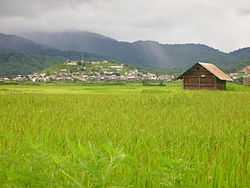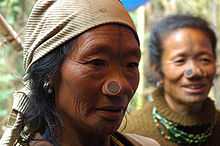Ziro
- For the province of Burkina Faso, see Zero Province. For the Star Wars character, see Ziro the Hutt.
| Ziro | |
|---|---|
| Hill station | |
 | |
 Ziro | |
| Coordinates: 27°33′59″N 93°49′53″E / 27.566389°N 93.831389°ECoordinates: 27°33′59″N 93°49′53″E / 27.566389°N 93.831389°E | |
| Country | India |
| State | Arunachal Pradesh |
| District | Lower Subansiri |
| Elevation | 1,700 m (5,600 ft) |
| Population (2001) | |
| • Total | 12,289 |
| Languages | |
| • Official | English |
| Time zone | IST (UTC+5:30) |
| PIN | 791120 |
| Telephone code | 03788 |
Ziro is a census town in Lower Subansiri district in the Indian state of Arunachal Pradesh. It has been a favorite town for World Heritage Site for a number of years now. In a meeting of Archeological Survey of India (ASI) on December 12, 2012 it was shortlisted for inclusion in Tentative List for further nomination to UNESCO for inscription in the World Heritage Site. [1]
Geography
27°33′59″N 93°49′53″E / 27.56639°N 93.83139°E
Ziro is the district headquarter of Lower Subansiri district and is one of the oldest towns in Arunachal Pradesh. It was the headquarters of the undivided Subansiri district comprising the present districts of Upper Subsansiri, Kurung Kumey, Lower Subansiri and Papum Pare. It is located at 27°38′N 93°50′E / 27.63°N 93.83°E[2] at an elevation of 1688 metres (5538 feet) to 2438 meters (8000 feet). Its cool weather in summer is its major attraction. It is famous for its pine clad gentle hills around it and rice field all around. Ziro is home to the Apa-Tani tribe.
Apa-Tanis have few unique special characteristic features which differs from other tribes in Arunachal Pradesh and India. Few of these special characteristic features are: (A) Apa-Tanis are permanently settled in one place whereas other tribes are nomadic in nature move from one place to another in search of fertile lands. They travel vast area of forests and settle temporarily for not more than four to five years in one place. (B) Apa-Tanis cultivate permanent wet land cultivations whereas other tribes practice dry land cultivations by clearing the forests by burning the jungles. (C) Apa-Tanis used to practice facial tattoos before; now they have dropped this custom few decades back.

Climate
The climatic condition of the district varies from place to place as well as season to season. The climate is largely influenced by the nature of terrain depending upon altitude and location of place. It may broadly be divided into four seasons in a year :
- the cold weather season is from December to February,
- March to May is the pre-monsoon season of thunders storms follows by,
- the South –West monsoon from June to about the middle of October and
- the second half of October to November which constitutes the post monsoon or the retreating monsoon period and is a period of transition.
In the foot hills or low high belt area of the district, the climatic condition is moderate in comparison to high belt areas, where during winter is very cold and chill, and in summer is pleasant. December and January are generally the coldest month, and July and August are warmest months.
Annual rainfall in the South is heavier than that in the Northern areas of the district. During the monsoon period more than 70 percent of the rain over the Southern half occurs while in the Northern portions it is about 60 percent. Variability of rain fall for the monsoon and the year ,as a whole, are relatively small. Average Annual Rainfall of the district Headquarter, Ziro recorded as 934.88 Cms.during, 2000.
Relative humidity is always high throughout the year except in the winter months being slightly less humid. In the cold season, the sky is abscurred on many mornings due to lifted fog which clears with the advance of the day generally, moderately clouded in the period of March to May, heavily clouded to overcast in the monsoon season and clear or slightly clouded during the post monsoon season. Winds are generally light strong katabatic winds down the valleys are experienced as local effect produced by the nature of terrain.
Demographics
As of 2001 India census,[3] Ziro had a population of 12,289. Males constitute 52% of the population and females 48%. In Ziro, 17% of the population is under 6 years of age.
Education
Ziro has the highest number of Schools in Arunachal Pradesh. There are more than hundred private and Government Schools and one undergraduate school-Saint Claret College- established by Claretian Missionaries. Ziro has an average literacy rate of 66%, lower than the national average of 74.04%: male literacy is 72%, and female literacy is 60%.
See also
- New Palin, a town in the Kurung Kumey district
References
- ↑ http://www.northeasttoday.in/our-states/arunachal-pradesh/arunachals-ziro-valley-talley-valley-for-unesco-word-heritage-site/
- ↑ Falling Rain Genomics, Inc – Ziro. Fallingrain.com. Retrieved on 2012-02-23.
- ↑ "Census of India 2001: Data from the 2001 Census, including cities, villages and towns (Provisional)". Census Commission of India. Archived from the original on 2004-06-16. Retrieved 2008-11-01.